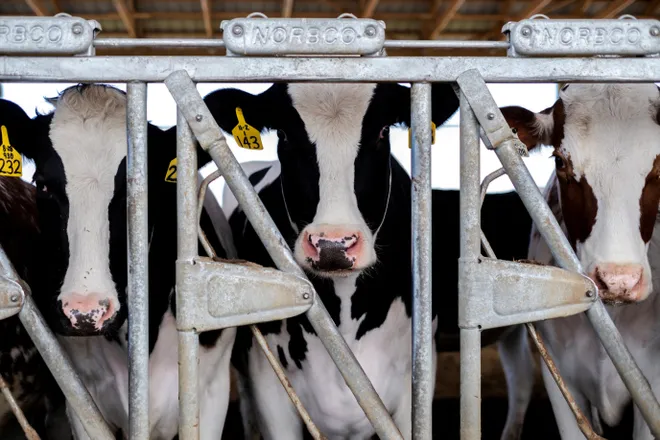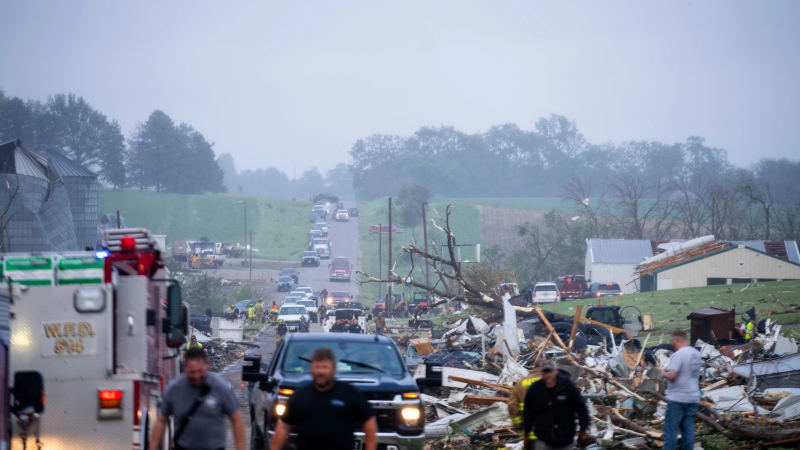CDC: Second human infected with bird flu linked to U.S. dairy cows
The U.S. has documented the second case of bird flu in 2024, the Centers for Disease Control and Prevention announced Wednesday.
Health officials identified the avian influenza case in a Michigan dairy farm worker. This is the second time a person working with dairy cows has developed the virus. The infection appears to have developed under similar circumstances as it did in March for a farm worker at a dairy in Texas.
A nasal swab from the infected person in Michigan tested negative for influenza, however, an eye swab from the patient tested positive for bird flu, indicating an eye infection, the CDC said in a news release. The infected person in the Texas case also showed only eye symptoms.
Bird flu:WHO's top scientist sounds alarm about bird flu and need for vaccine development

Although the two cases happened within a relatively short period, officials at the CDC said the new case doesn’t change their assessment that the risk to human health remains low.
It’s unclear when the person contracted bird flu and the CDC did not provide further details about the worker. The Michigan Department of Health and Human Services also declined to provide more information about the new case, due to labor and farm privacy concerns.
Dr. Nirav Shah, principal deputy director for CDC, said the federal agency received the samples from the Michigan worker on Tuesday and reported the positive results that night. Genetic sequencing for the virus in the new case is pending.
The Michigan worker had worked on a farm that was actively monitoring for infected livestock. The person reported symptoms via text message, mentioning they had eye redness, Shah said.
Although the two cases in Texas and Michigan happened over a couple of months, officials at the CDC said the new case doesn’t change their assessment that the risk to human health remains low. Shah explained some key epidemiological factors of transmission, namely how close dairy workers are to animals when they work with cows.
“We were not surprised to find that there is and was a second case,” Shah told reporters Wednesday afternoon. “It does not change our assessment of the risk overall.”
Still, the CDC has recommended precautions that people exposed to infected birds or livestock should take. The guidance calls for the use of personal protective equipment, or PPE, such as goggles, N95 masks and gloves.
Officials in Michigan said they had initiated “a swift public health response" and began tracking the situation closely after influenza A, or H5N1, was detected in local poultry and dairy herds."

"Farmworkers who have been exposed to impacted animals have been asked to report even mild symptoms, and testing for the virus has been made available,” Dr. Natasha Bagdasarian, chief medical executive for Michigan, said in a statement. “The current health risk to the general public remains low. This virus is being closely monitored, and we have not seen signs of sustained human-to-human transmission at this point."
The U.S. saw its first known bird flu case in 2022, but the virus in that case wasn't contracted from dairy cows. An incarcerated Colorado man who had been slaughtering chickens was presumed to have gotten H5N1 from the birds, according to a CDC news release at the time. The man's only symptom was fatigue and he recovered after being treated with an influenza antiviral drug.
In the 2024 outbreak, 40 people have been tested for bird flu, Shah said. And about 170 people are enrolled in the active monitoring system, officials said.
Federal health and agriculture officials implemented an order in late April restricting the movement of cattle from infected states. The order also required testing, reporting positive results and genetic sequencing.
On Wednesday, Eric Deeble, deputy assistant secretary of the U.S. Department of Agriculture, said the federal agency has moved to expand financial support to dairy farms that have not had infected cows as a matter of biosecurity and in hopes of reducing the risk of spreading the virus. The USDA will also cover the cost of testing and shipping of test results. For farms that have had herds infected with H5N1, the agency plans to compensate farmers for the loss of income from milk cows that don’t produce due to illness, Deeble said. These payments will be retroactive, Deeble said.
Dawn O'Connell, assistant secretary for the Administration for Strategic Preparedness and Response, said the agency was working to supplement PPE stockpiles in five states, and making Tamiflu, an antiviral medication, available to jurisdictions that don’t have a stockpile. The U.S. Department of Health and Human Services, which oversees the strategic response team, has also begun the fill-and-finish process for approximately 4.8 million doses of vaccine matched to the current circulating strain of H5N1, through the National Pre-pandemic Influenza Vaccine Stockpile Program. They have not begun to distribute the shots.
O'Connell said readiness is the goal: "This step further strengthens our preparedness posture."
Disclaimer: The copyright of this article belongs to the original author. Reposting this article is solely for the purpose of information dissemination and does not constitute any investment advice. If there is any infringement, please contact us immediately. We will make corrections or deletions as necessary. Thank you.






